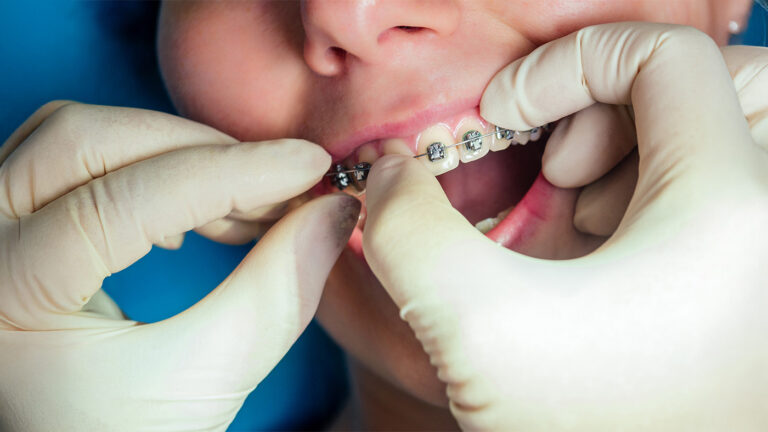So you’re thinking about getting braces… but then you remember, “Wait—I’ve got crowns” or maybe veneers. Maybe even a dental implant. And now you’re wondering if orthodontic treatment is still an option. Let me stop you right there: Yes, you absolutely can get orthodontic treatment! Don’t let a little dental history keep you from getting the smile you’ve been putting off.
In most cases, starting orthodontic treatment with braces is relatively straightforward. An orthodontist will assess the state of your teeth and jaw, identify any concerns, and develop a customized treatment plan. Braces work by wires gently moving your teeth into place using brackets that are attached to the teeth. Clear aligners, like Invisalign, work similarly but aren’t attached to the teeth like braces. Aligners use glue bumps called attachments bonded to the teeth to increase the aligners “grip” the teeth. And while it’s true that most brackets and attachments are designed to bond to natural enamel, modern orthodontics have come a long way.
Straightening Your Smile if You Have Crowns or Veneers
Braces are an effective treatment for a wide variety of dental ailments known as malocclusions, ranging from crowded or crooked teeth to misalignments of the jaw and more. Some people may delay or even avoid braces because they’re worried previous dental work will get in the way. If you have undergone previous dental work, such as crowns, veneers, or dental implants, your orthodontist can use special techniques and adhesives that work just fine.
And if you’ve got a situation where a bracket won’t hold well? That’s where clear aligners like Invisalign come in. They apply pressure across the whole tooth—great for protecting any dental work while still getting results.
If you need crowns or veneers but haven’t yet received them, your orthodontist may recommend completing your orthodontic treatment before proceeding with other dental work. Otherwise, your orthodontist will assess your dental situation, including any past dental work, and determine the best treatment path.
What about implants? Implants don’t move. They’re anchored into your jawbone and built to stay put. That sounds like a problem, right? Not really. Your orthodontist can plan around them. They’ll shift the teeth that can move and design a plan that still gives you a straighter, healthier smile.
Options for Straightening Teeth with Crowns and Veneers
There are two common types of orthodontic options. The first is conventional braces, a collection of metal or ceramic brackets, wires, and elastic bands placed on the front of the teeth. The second is clear aligners, such as Invisalign. Because aligners are custom-made to fit your mouth, they can be formed to fit over and around existing dental work.
Conventional Braces
Conventional braces are great for full control and long-term results, even with crowns or veneers. Orthodontists use specialized bonding agents or adhesives to stick metal brackets harmlessly to the surfaces of teeth. They are designed to keep the brackets in place over the long term and separate them without damage when their job is done. They are also designed specifically for contact with tooth enamel.
For artificial surfaces like crowns or veneers, your orthodontist will use a specialized bonding agent designed to achieve the same results without damaging your prior dental work. When treatment is completed, brackets are carefully removed from the crown or veneer.
Clear Aligners
Aligners are an awesome choice if you want something more subtle and gentle on dental work. Depending on your situation, an orthodontist may prefer not to attach brackets directly to a crown, veneer, or other existing dental work. Clear aligners may be recommended if there isn’t enough reliable surface area to attach a bracket. Fortunately, aligners are an effective treatment method and have some additional fringe benefits.
Conventional braces apply pressure only at the bracket, while aligners apply pressure along the entire tooth. The risk of damage to previous dental work is lowered when forces are spread across the entire crown or veneer. Aligners are also less noticeable than other types of braces, making them more appealing to some patients.
Whatever route you take, the key is working with someone who knows how to tailor the plan to your mouth—not just a cookie-cutter approach. if you’ve been holding off on braces because of crowns, veneers, or past dental work, it’s time to stop waiting. The truth is, there’s never a “perfect time.” But there’s always a right time to start. You can still get a healthy, confident smile—it just takes the right plan and the decision to move forward. And that decision? It starts with you.
Be sure to check out our current orthodontic special for kids, teens, and adults and schedule a free consultation today.




